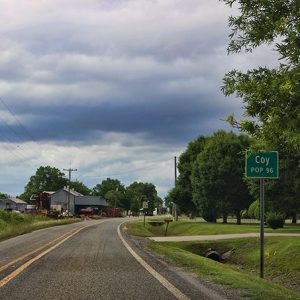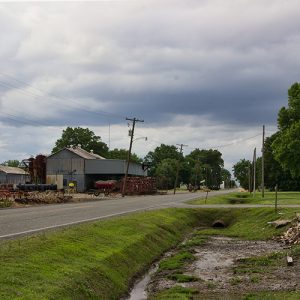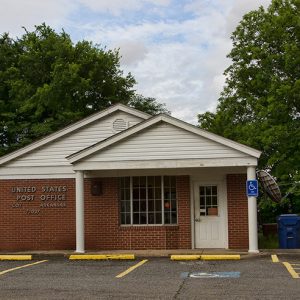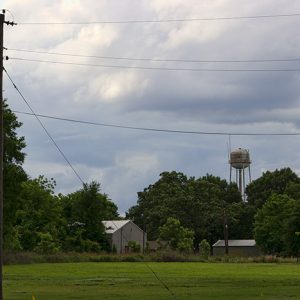calsfoundation@cals.org
Coy (Lonoke County)
| Latitude and Longitude: | 34°32’19″N 091°52’26″W |
| Elevation: | 242 feet |
| Area: | 0.67 square miles (2020 Census) |
| Population: | 87 (2020 Census) |
| Incorporation Date: | April 15, 1902 |
Historical Population as per the U.S. Census:
|
1810 |
1820 |
1830 |
1840 |
1850 |
1860 |
1870 |
1880 |
1890 |
1900 |
|
– |
– |
– |
– |
– |
– |
– |
– |
– |
– |
|
1910 |
1920 |
1930 |
1940 |
1950 |
1960 |
1970 |
1980 |
1990 |
2000 |
|
– |
– |
– |
– |
– |
206 |
240 |
183 |
142 |
116 |
|
2010 |
2020 |
|
|
|
|
|
|
|
|
|
96 |
87 |
|
|
|
|
|
|
|
|
The story of Coy is the same as that of many rural Arkansas communities that have almost disappeared since the inception of the automobile and mechanized farming. It was the hub of the cotton growing and ginning industry in south Lonoke County from 1900 until the early 1960s.
On November 3, 1896, Abby M. Coy—wife of “Colonel” Lucien W. Coy, who established the town—purchased the land that would become Coy from one F. Gates. Lucien Coy had been a first lieutenant with the Union in Missouri’s First Engineering Regiment, Company B, and he came south after the Civil War and engaged in lending money and land speculation in Little Rock (Pulaski County).
The exact date of the town’s establishment is unclear. A contract dated July 7, 1902, between Abby Coy and Andrew Jackson Walls shows that Walls bought property in the town, described on a map of J. E. Keiser’s made on April 15, 1902. The map evidently was never recorded. In 1918, county surveyor M. Y. Smith replatted the town site and wrote that his plat was to replace a 1912 plat, but neither of these records is on file. Because the Coy-Walls contract is dated 1902, it appears to be the date of establishment. Later in 1919, a plat and a bill of assurance were notarized in New Hampshire by Coy.
In April 1903, Walls, with J. E. Coleman, bought a piece of land and built a cotton gin and a store. A year later, Walls transferred his interest in the gin and property to Coleman. This gin and store became the nucleus of the town. Lucien Coy built a home on adjoining property, lived there, and operated a store there with his son, Luther. In November 1909, Coy deeded his home to Coleman and discontinued his association with the town.
The town had a logging railroad that extended from England (Lonoke County), five miles to the west, to a sawmill three to four miles east. In November 1909, the Central Arkansas & Eastern Railroad was granted a right of way after the takeover of the logging railroad by the Cotton Belt line. The railroad was improved and extended to Stuttgart (Arkansas County); stations and section houses were built, two such houses being east of the Coy platted area. A depot was built about 1910 in the Stick/Eastlake architecture style. Because of its architecture, it is on the National Register of Historic Places. The railroad made it easier to ship cotton to other areas and provided more jobs.
In 1913, with the advent of the automobile and better roads, the road through town was moved from the west to the east side of town. Coleman moved his store there to be on the highway. A Masonic Lodge hall was above the store. The railroad was also relocated to be along the highway. John H. Garner, who had farmed nearby, operated a store across the railroad and next to the highway.
Three physicians served the town in its early days, one Dr. Hardy (possibly Frank Prior Hardy), Dr. Luther W. White, and Dr. Earnest Hugh Harris, the last doctor to practice in the town. J. H. Garner was named the first postmaster in 1913 and served until 1924, when he was succeeded by James M. Woosley Jr. With the opening of this post office, the post office at Tomberlin (Lonoke County) closed in July 1915.
Henry Reddick operated a blacksmith shop in Coy and, with increased automobile travel, began selling gasoline and providing automobile repair. A man named Blankenship operated a store and a gristmill. Jess L. Lemons practiced blacksmithing at the site. Clyde Emmet Pickens operated a general merchandise store, with a soda fountain and medicine.
The area’s principal source of income was cotton. With improved varieties and cultivation practices, production increased until better ginning facilities were needed. In 1919, Sam Dardenne and Willis S. Chaney built a new gin next to the railroad. This led to the introduction of electricity in Coy, as the gin was electrically powered. The Coleman store was operated in conjunction with the gin. The store was destroyed by fire in 1924, but the gin remained.
The Coy economy was severely affected by the Depression, along with every other place in Arkansas, especially regions dependent upon cotton. A food riot held in nearby England is indicative of the bad conditions in the area.
Two churches served the community historically. In 1921, the Coy Baptist Church led by Reverend R. P. Bain began operation. It met in a building formerly owned by the Coy Missionary Baptist Church. After remodeling the sanctuary and adding an education building, the church was rededicated on February 24, 1957. The 1940s and 1950s were the church’s best years, but the 1990s saw poor attendance, and on June 27, 1997, it was disbanded and the property sold. The building, which was briefly a restaurant, is today a private residence. Most of the members became associated with the First Baptist Church of England (Lonoke County). The Coy Church of Christ began meeting at Coy in 1950. It had met at McClung (Lonoke County) from 1938–1942. A new building was constructed in 1950. It still holds services today.
Today, Coy is one of Arkansas’s disappearing communities. There is one gin that processes the cotton brought in modular units by truck. It remains a productive cotton and soybean farming area.
For additional information:
Cordell, Anna Harmon. History of the Arkansas Society Daughters of the American Revolution. N.p., 1929.
Young, R. L. History of Lonoke County, Arkansas. England, AR: Citizen Bank & Trust, 1923.
Joseph Edward Walls
England, Arkansas
Edwina Walls Mann
Little Rock, Arkansas
 Coy
Coy  Coy
Coy  Coy Post Office
Coy Post Office  Coy Train Depot
Coy Train Depot  Coy Water Tower
Coy Water Tower  Lonoke County Map
Lonoke County Map 




Comments
No comments on this entry yet.